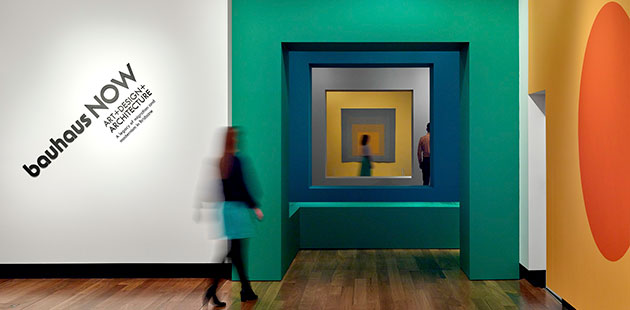 Discover why a 20th century German design school is still considered one of the most influential schools of art and design at Museum of Brisbane’s new exhibition Bauhaus Now: art+design+architecture, a legacy of migration and modernism in Brisbane.
Discover why a 20th century German design school is still considered one of the most influential schools of art and design at Museum of Brisbane’s new exhibition Bauhaus Now: art+design+architecture, a legacy of migration and modernism in Brisbane.
Bauhaus Now brings to life the little-known story of how revolutionary ideas of the Weimar Republic in Germany influenced modernist art, design and architecture in Brisbane and Australia.
Museum of Brisbane Director Renai Grace said Bauhaus Now highlights the migrant and refugee contribution to Australian life and art history both during and after the Second World War. “To understand modern design, you need to start with the Bauhaus, the most influential art and design school in history,” said Ms Grace.
Founded in the German city of Weimar in 1919, the Bauhaus art and design school operated until it was closed by the Nazi regime in 1933. However, many of the teachers and students continued the legacy of its principles, including migrants and refugees to Australia.
Through these exiles and internees – including artist Ludwig Hirschfeld-Mack (1893–1965) and iconic Australian architect Harry Seidler (1923-2006) – educational ideas filtered into Australia and had a profound impact on art, design and architecture.
Along with Hirschfeld-Mack and Seidler, Bauhaus Now also documents the impact of other notable Bauhaus practitioners: Karl and Gertrude Langer; Wassily Kandinsky; Marianne Brandt; Josef Albers; Marcel Breuer; Paul Klee; Laszlo Moholy-Nagy as well as local contemporary artists including Michael Candy and Christopher Handran.
Comprising almost one hundred pieces including furniture, design, paintings, printmaking, film, textiles, photography, sculpture, architectural plans and historical imagery, the exhibition shows how revolutionary ideas of the Bauhaus influenced modernist art, design and architecture, and how the legacy of these powerful ideas is being re-interpreted today.
Curator Andrew McNamara said imaginative recreations by local Brisbane artists would be featured alongside original Bauhaus works.
“There are Hirschfeld-Mack’s important contributions to Bauhaus teaching: George Teltscher’s counterfeit internment camp banknotes; a whole section on Brisbane on the front line of the Second World War; and Harry Seidler whose Riverside design showed Brisbane how to face its river and turn it into a feature of the city,” he said.
Designed by Speculative Architecture, the exhibition space features striking colour and architectural form to reflect the principles of Bauhaus teaching.
Bauhaus Now
Museum of Brisbane, Level 3 – Brisbane City Hall, King George Square, Brisbane
Exhibition continues to 18 April 2021
Free entry (with a timed ticket)
For more information, visit: www.museumofbrisbane.com.au for details.
Image: Museum of Brisbane, Bauhaus Now: art+design+architecture, a legacy of migration and modernism in Brisbane (installation view) – photo by Toby Scott
